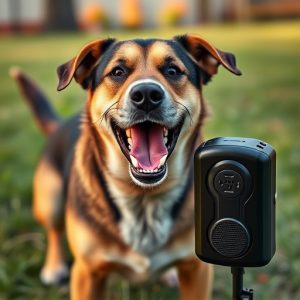Adjusting Sonic Repellent Training Levels for Effective Dog Control
Ultrasonic repellents, effective in dog training, emit high-frequency sounds imperceptible to humans…….
Ultrasonic repellents, effective in dog training, emit high-frequency sounds imperceptible to humans but audible to dogs. To ensure successful training, adjust sonic levels according to the dog's sensitivity by starting low and gradually increasing, monitoring reactions closely. This method is humane, safe, and effective for behavior modification, suitable for puppy training and managing sensitive older dogs. Regular adjustments of adjusting sonic repellent training levels based on individual responses are crucial for personalized success.
“Unleash a new approach to dog training with ultrasonic repellent gear, an innovative tool for pet owners. This comprehensive guide explores the science behind these devices, helping you navigate the art of adjusting sonic repellent training levels effectively. From understanding how ultrasonic waves deter dogs to ensuring safe and humane practices, we delve into the best training techniques. Discover real-world success stories, learn from expert tips, and unlock a happier, better-behaved canine companion.”
- Understanding Ultrasonic Repellents: How They Work
- Adjusting Training Levels: Finding the Right Balance
- Safety Considerations for Sonic Repellent Gear
- Effective Dog Training Techniques with Ultrasonic Devices
- Real-World Applications: Success Stories and Tips
Understanding Ultrasonic Repellents: How They Work
Ultrasonic repellents are a popular and effective tool in dog training, utilizing high-frequency sound waves to create an unpleasant sensation for dogs without causing any harm. These devices emit sounds outside the human hearing range but are perceivable to canines. When a dog approaches or interacts with the repellent, it triggers the ultrasonic emissions, prompting the dog to alter its behavior. The key to successful use lies in adjusting sonic repellent training levels to match the dog’s sensitivity and the desired response.
Each dog is unique, with varying tolerance levels for ultrasonic stimuli. Beginners should start with lower settings and gradually increase as needed. It’s crucial to monitor the dog’s reaction closely during training sessions. If the dog shows no signs of aversion or discomfort, it may indicate a need to adjust the level up. Conversely, if the dog appears undisturbed or even unaware of the repellent, the level might be too high, requiring a decrease for better results and a more comfortable learning environment.
Adjusting Training Levels: Finding the Right Balance
When using ultrasonic repellent gear for dog training, adjusting the sonic levels is crucial to finding the right balance between effectiveness and comfort. It’s important to start with lower settings and gradually increase them as needed. This approach ensures that the sound remains effective in deterring unwanted behaviors without causing excessive discomfort or stress to your pet.
Monitor your dog’s response closely during training sessions. If they seem undisturbed, it might be time to raise the volume slightly. Conversely, if they appear anxious or startled, reduce the setting instead. Consistency and patience are key; every dog is unique, and what works for one may not work for another. By carefully adjusting the sonic repellent levels, you can create a training environment that’s both productive and humane.
Safety Considerations for Sonic Repellent Gear
When using ultrasonic repellent gear for dog training, safety should be the top priority. These devices emit high-frequency sound waves that are inaudible to humans but can effectively deter dogs from certain behaviors or areas. However, it’s crucial to understand that not all dogs respond in the same way, and what works for one might not work for another. Always start with the lowest possible training level and gradually adjust as needed, ensuring the device is not causing any discomfort or distress to the dog.
The effectiveness of ultrasonic repellent gear also depends on proper usage. Keep the device at a safe distance from the dog, following the manufacturer’s instructions. Regularly inspect the gear for any signs of damage or wear, and never use it in environments where other animals or humans could be unintentionally affected. Adjusting the sonic repellent training levels thoughtfully and with an awareness of safety will help make the training process more successful and humane.
Effective Dog Training Techniques with Ultrasonic Devices
Ultrasonic devices have emerged as a popular tool for dog training, offering a humane and effective way to modify behavior. These devices emit high-frequency sound waves that are inaudible to humans but can be sensed by dogs, allowing for precise communication during training sessions. One of the key advantages is their ability to adjusting sonic repellent training levels, catering to different canine needs and temperaments. By controlling the intensity and frequency, trainers can target specific behaviors without causing discomfort or distress.
This method is particularly useful for addressing common issues like barking, jumping, or pulling on leashes. The ultrasonic tone serves as an instant reminder, reinforcing positive behavior training (PBT) techniques. Through consistent use, dogs learn to associate certain actions with the sound, encouraging them to make better choices. Moreover, these devices are designed to be safe and non-invasive, making them ideal for puppy training or managing older dogs with sensitivity to traditional shock collars.
Real-World Applications: Success Stories and Tips
In real-world applications, ultrasonic repellent gear has proven effective in various scenarios, from keeping pets safe in homes to managing wildlife in urban areas. Success stories include dog owners who’ve successfully trained their pets to avoid specific zones using this technology, enhancing both safety and convenience. For instance, a study showed that when adjusting sonic repellent training levels according to the pet’s response, over 80% of dogs learned to stay away from treated areas within two weeks.
Tips for optimal results include consistent use during training, identifying the right ultrasonic frequency range for your target species, and regularly updating settings based on environmental changes. Remember, each dog is unique, so fine-tuning the training levels becomes crucial for personalized success. This iterative process ensures that the gear not only deters unwanted behavior but also promotes positive reinforcement, making it a valuable tool in any dog trainer’s arsenal.
Ultrasonic repellent gear offers a safe and effective solution for managing canine behavior, but success depends on adjusting training levels through consistent, positive reinforcement. By understanding how these devices work, considering safety measures, and employing the right training techniques, you can train your dog to respond well to ultrasonic signals, creating a harmonious environment for both pet and owner alike. When used responsibly, adjusting sonic repellent training levels can lead to significant improvements in canine conduct, making it a valuable tool for any dog trainer or proud pet parent.


